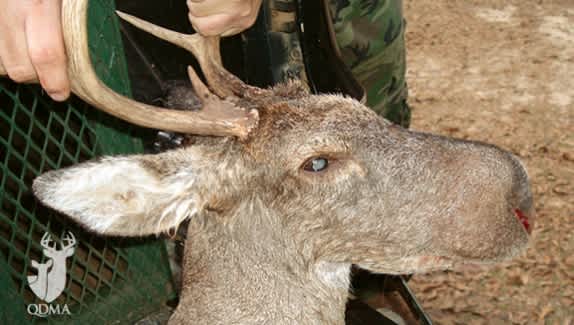“Bullwinkle” Deer Syndrome
Daniel Xu 01.15.14

The whitetail in the above photo has not been photoshopped, nor is it a one-of-a-kind occurrence. The deer suffers from what researchers call “Bullwinkle” syndrome, after the cartoon character Bullwinkle J. Moose. Much like their namesake, deer afflicted with this illness display a rounded, moose-like snout very different from that of a healthy white-tailed deer. According to Dr. Kevin Keel, a researcher at the University of California Davis, the first documented case of this bizarre disease appeared in 2002.
“It was a deer submitted to the Southeastern Cooperative Wildlife Disease Study by Chuck Sharp from the Alabama Department of Conservation and Natural Resources. Since then I’ve received a small number of similar cases each year,” Keel wrote to me in an email. “The reason that the deer have such a bulbous nose is that the soft tissues in that area are swollen by chronic inflammation. This inflammation is caused by a bacterial infection.”
Keel said he can’t be certain the disease is a new one. Instead, he speculates the prevalence of modern technology such as trail cameras and smartphones were responsible for the increase of “Bullwinkle” sightings.
“Now that everyone has a digital camera on their telephone, and a dozen deer cams around their hunting lease, more and more people are sending us photographs of such deer,” Keel wrote. “Many of the cases I’ve examined have started with such photographs. After I receive an e-mail asking me what’s wrong with the deer, I encourage them to submit the deer, or samples of tissue, and the case gets added to the database.”
Deer affected by the infection were seen most commonly feeding at bait sites. According to the Quality Deer Management Association (QDMA), hunters have submitted numerous specimens or trail cam footage of “Bullwinkle” deer. The QDMA speculates that while the affliction must be uncomfortable for the deer, it is not necessarily fatal. As a precaution however, the organization advises hunters who harvest these animals to avoid eating the meat until more is known about the infection.
Since the 2002 case, hunters provided researchers with a wealth of data as more “Bullwinkle” deer were frozen and sent in for study. Despite only affecting a very small amount of deer and possibly other ungulates, the disease has been encountered in many states.
“Deer affected by this disease have been submitted from Maryland to Idaho and Alabama to Michigan,” Keel stated.
Keel and his research team at the Department of Pathology, Microbiology & Immunology at UC Davis have manged isolate the species of bacteria involved with the disease, and intend on publishing the results soon.
Fortunately for the deer, Keel and other experts agree the disease affects such small numbers that it should not affect the overall population. Deer are tough critters, and are not likely to let a swollen nose get the better of them.
You can see more pictures of deer with the “Bullwinkle” syndrome at QDMA’s site here.

